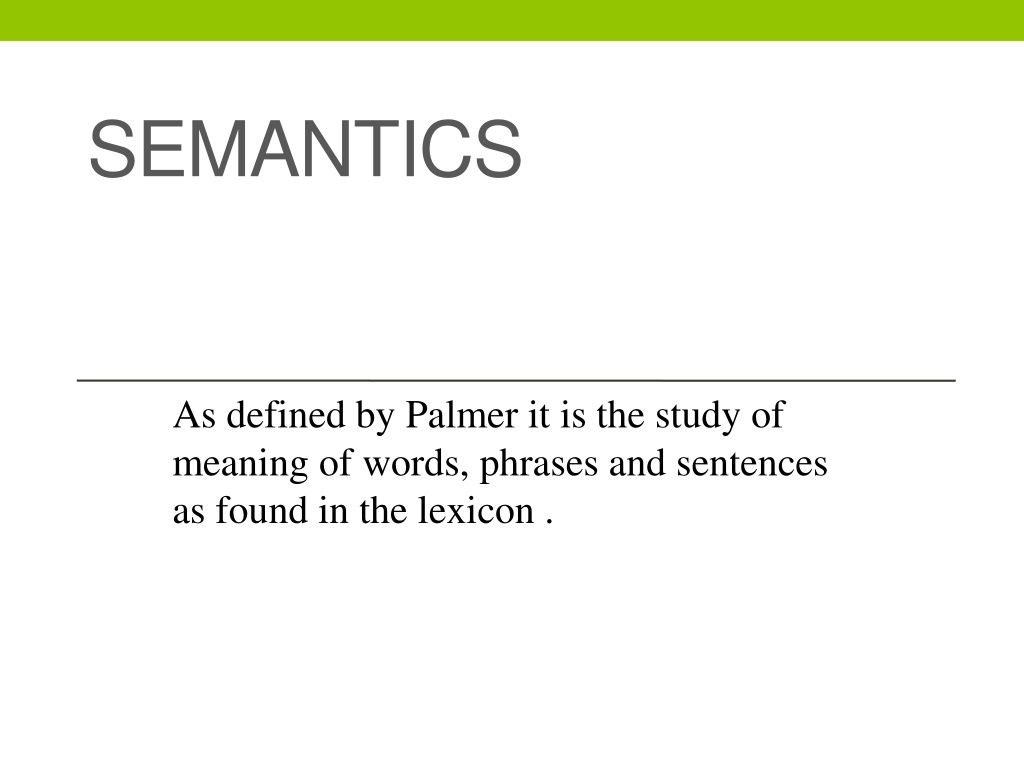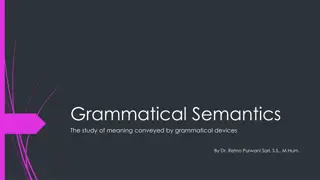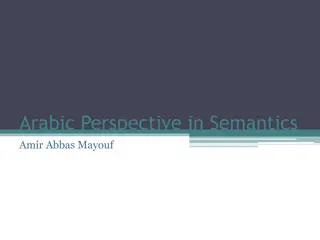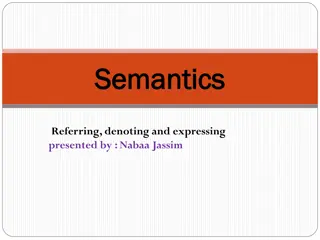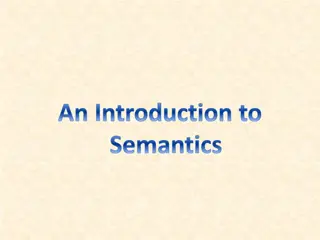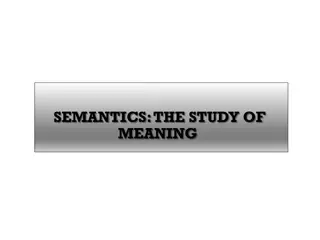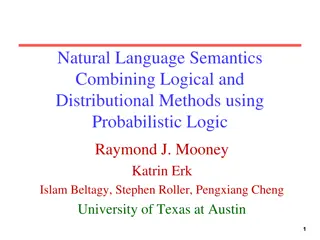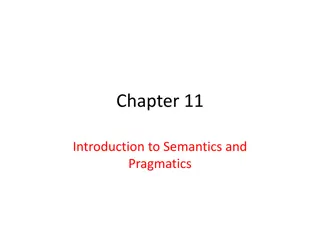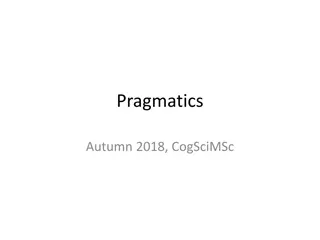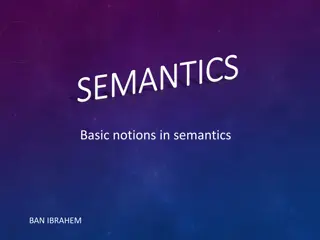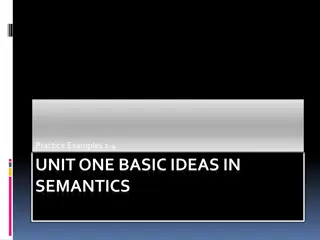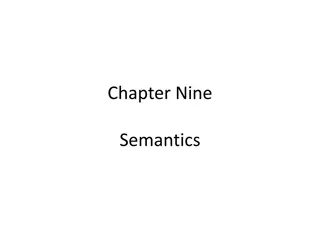Exploring Historical Semantics: Evolution of Meaning in Words
Historical semantics delves into the evolution of word meanings, tracing changes like narrowing, widening, metaphor, metonymy, synecdoche, hyperbole, and more. It examines reasons for semantic shifts, such as taboo, new needs, and sound laws, aiming to establish linguistic connections and reconstruct language histories.
Download Presentation

Please find below an Image/Link to download the presentation.
The content on the website is provided AS IS for your information and personal use only. It may not be sold, licensed, or shared on other websites without obtaining consent from the author. Download presentation by click this link. If you encounter any issues during the download, it is possible that the publisher has removed the file from their server.
E N D
Presentation Transcript
SEMANTICS As defined by Palmer it is the study of meaning of words, phrases and sentences as found in the lexicon .
Historical semantics It was noted earlier that that the term semantics was first used to refer to the development and change of meaning. The great American linguist, Bloomfield (1933:427-7) , noted a number of types , each given a traditional name as shown below: Narrowing: meat food Widening: bird nestling Metaphor: bitter biting Metonymy: jaw cheek
Historical semantics Synecdoche (whole / part relation ) : town fence Hyperbole (stronger to weaker meaning ) : astound strike with thunder Litotes ( weaker to stronger meaning ) : kill torment Degeneration: knave boy Elevation: knight boy
Historical semantics We shall also try to find reasons for the changes. The word money is related to Latin moneo which means 'warn' (cf. admonish) used at wars to scare the Germans . Other changes arise from new needs: The word car was an obsolete poetic word for chariot', until the motor-car was invented.
Historical semantics A cause of last change is taboo , a word that is used for something unpleasant is replaced by another and that too is again had the terms privy, W.C., lavatory, toilet, bathroom, and more recently, loo. Historical change is what is more commonly called comparative philology, which attempts both to reconstruct the history of languages and to relate language apparently coming from a common ancestor .
Historical semantics One of the aims of this subject is to establish sound laws . Sound laws: the relation between words that have the same origin . we find words that according to the sound laws are related, and then look for a reasonable semantic relationships but, Unhappily this is not possible with all languages because we have no ancient records for all languages around the world .
Historical semantics There are attempts have been made to relate words from different African languages because of some phonetic similarity, with no sound laws, on the basis of the meanings like: 'day', 'sun', fire , and, similarly, 'sky', 'above', 'rain'. But such identifications are not very persuasive.
Etymology Etymology: is the discovery of earlier meanings of words. The first serious discussion is in Plato's Cratylus; many of the suggested etymologies there are illogical, but a number of them are basically correct. Part of the difficulty for the layman is that words are often not what they seem. Gooseberry has nothing to do with geese, and strawberry is not directly connected with the use of straw . But few would expect hysterical to be connected with womb (in Greek) or the words lord and lady have anything to do with loaf (of bread). Etymology, even if it has curiosity value but there should be no place for it in dictionaries.
Etymology The chief difficulty is that there can be no or 'original' meaning since human language stretches back too far like: nice used to mean precise, but a study of its history shows that it once meant silly' (Latin nescius 'ignorant ), and earlier it must have been related to ne not and sc probably meaning 'cut' as in scissors . And before that? We cannot know. Clearly, then, no serious discussion of etymology is required here.
Etymology A distinction made explicit by de Saussure (1916: 117[1959:81]) between diachronic and synchronic linguistics: The diachronic: concerned with language through time. The synchronic : concerned with language as it is, or as it was at a particular time. Linguists have in years concentrated on the synchronic study of language .because synchronic study must precede the diachronic study, for we cannot study change in a language until we have first established what the language was like at the time during which it changed.
Paradigmatic and syntagmatic The paradigmatic relations are those into which a linguistic unit enters through being contrasted or substitutable, in a particular environment, with other similar units. (vertical). The Syntagmatic relations are those that a unit contracts by virtue of its co-occurrence with similar units. (horizontal). ex:- Red door paradigmatic relation between the words red and green Green door Syntagmatic relation between the words green and door
Paradigmatic and syntagmatic Many of the basic ideas derive from de Saussure's notion of value. He pointed out (1916: 153 (1959: 110) that : a knight on a chess board is a knight not because of inherent quality (shape, size, etc.), but because of what it can do in relation to the other pieces on the board. He stressed this relational aspect of language. For instance, he argued that sheep in English has a different value from mouton in French because English has also the word mutton.
Paradigmatic and syntagmatic Similarly plural in Sanskrit has a different value from plural in French (or English), because in Sanskrit it belongs to the three- term system singular, dual, plural, while in French it belongs to a two-term system of singular and plural only.
Deixis Deixis: are elements of language that are so contextually bound. ex: here, there, I and we etc.. The original form of the word is ( deictic) from the noun deixis that comes (from the Greek deiknymi) which means to show or to point out .
Deixis / Spatial deixis : The deictic devices in a language commit a speaker to set up a frame of reference around herself . To take a simple example, adverbs of location can be used deictically as : Ex: it's too hot here in the sun, let's take our drinks into the shade over there. The adverbs here and there pick out places according to their proximity to the location of the speaker. We can see this because, of course, if the speaker moves, the interpretation of the adverbs will change. When the speaker and her addressee have moved , they can call the shade here and in the sun there Ex: I m glad we moved here, I was melting over there .
Deixis / Spatial deixis : While languages contain such deictic divisions of space, their use has to be calculated by the participants in actual contexts. For example, how big an area is meant by here depends on context : A speaker might use here to refer to a country, a city, a room and so on. Deixis may include information about motion toward or away from the speaker . Ex: - Don t come into my bedroom - Don t go into my bedroom
Deixis / person deixis : Person deixis : deictic system grammaticalizes the role of participants if it was the current speaker , addressee or others by pronouns : First person singular pronoun for speaker Second person pronoun for addressee Third-person category for neither the speaker nor addressee Singular plural singular or plural I we you he they she
Deixis / social deixis : social deixis: deictic system grammaticalizes the social identities or relationships of the participants in the conversation . Ex: familiar and polite pronouns in many European languages . Ex: French : tu/ vous s'il vous pla t s'il te pla t *Tu is often referred to as the familiar form, and vous as the formal or polite form.
Reference and content Much of reference rely on context, a clear example is what Clark (1978) calls shorthand, which is a type of reference that relies on the context . Ex: I am looking for the new wolf i.e.(Wolfe) Here the speaker felt that the new Wolfe will be absolutely sufficient for the book seller to identify the new book by Tom Wolfe Ex: He is here for a month He is here for the month
Sense and reference Sense: is the relationship inside language, the relationship between the words phrases and sentences . Reference: is the relationship between language and outside world . Ex: Eiffel tower / refers to a tower in Paris Taj Mahal / refers to a beautiful marble building at Agra in India . However, there are words in every language that do not refer to anything in the world . Words like and, or, if and almost there words have sense but don t have reference.
References Saeed, J. (2009). Semantics. 4th edition. Blackwell. Palmer, F.R. (1981). Semantics. 2ndedition. Cambridge University Press. Thakur, D. (1999). Linguistics Simplified Semantics. Bharati Bhawan. Riemer, N. (2010). Introducing Semantics. Cambridge University Press. http://www.french- linguistics.co.uk/grammar/tu_and_vous.shtml https://french.stackexchange.com/questions/8052/usage-of- veuillez-and-sil-vous-pla t
